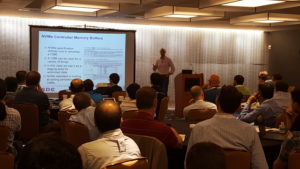Whether storage is already a main focus of your career or may be advancing toward you, you’ll definitely want to attend the flagship event for storage developers – and those involved in storage operations, decision making, and usage – SNIA’s 19th annual Storage Developer Conference (SDC), September 11-14, 2017 at the Hyatt Regency Santa Clara, California. Read More
Category: Linear Tape File System
SNIA Storage Developer Conference-The Knowledge Continues
SNIA’s 18th Storage Developer Conference is officially a success, with 124 general and breakout sessions; Cloud Interoperability, Kineti c Storage, and SMB3 plugfests; ten Birds-of-a-Feather Sessions, and amazing networking among 450+ attendees. Sessions on NVMe over Fabrics won the title of most attended, but Persistent Memory, Object Storage, and Performance were right behind. Many thanks to SDC 2016 Sponsors, who engaged attendees in exciting technology discussions.
c Storage, and SMB3 plugfests; ten Birds-of-a-Feather Sessions, and amazing networking among 450+ attendees. Sessions on NVMe over Fabrics won the title of most attended, but Persistent Memory, Object Storage, and Performance were right behind. Many thanks to SDC 2016 Sponsors, who engaged attendees in exciting technology discussions.
For those not familiar with SDC, this technical industry event is designed for a variety of storage technologists at various levels from developers to architects to product managers and more. And, true to SNIA’s commitment to educating the industry on current and future disruptive technologies, SDC content is now available to all – whether you attended or not – for download and viewing.
 You’ll want to stream keynotes from Citigroup, Toshiba, DSSD, Los Alamos National Labs, Broadcom, Microsemi, and Intel – they’re available now on demand on SNIA’s YouTube channel, SNIAVideo.
You’ll want to stream keynotes from Citigroup, Toshiba, DSSD, Los Alamos National Labs, Broadcom, Microsemi, and Intel – they’re available now on demand on SNIA’s YouTube channel, SNIAVideo.
All SDC presentations are now available for download; and over the next few months, you can continue to download SDC podcasts which combine audio and slides. The first podcast from SDC 2016 – on hyperscaler (as well as all 2015 SDC Podcasts) are available here, and more will be available in the coming weeks.
SNIA thanks all its members and colleagues who contributed to make SDC a success! A special thanks goes out to the SNIA Technical Council, a select group of acknowledged industry experts who work to guide SNIA technical efforts. In addition to driving the agenda and content for SDC, the Technical Council oversees and manages SNIA Technical Work Groups, reviews architectures submitted by Work Groups, and is the SNIA’s technical liaison to standards organizations. Learn more about these visionary leaders at http://www.snia.org/about/organization/tech_council.
And finally, don’t forget to mark your calendars now for SDC 2017 – September 11-14, 2017, again at the Hyatt Regency Santa Clara. Watch for the Call for Presentations to open in February 2017.
Linear Tape File System Now an International Standard
By David Pease, Co-Chair SNIA Linear Tape File System Technical Working Group
In 2011 the Linear Tape File System (LTFS) earned IBM an Engineering Emmy Award after being recognized by FOX Networks for “improving the ability of media companies to capture, manage and exploit content in digital form, fundamentally changing the way that audio and video content is managed and stored.” Now, the International Standardization Organization (ISO) has named LTFS an International Standard (ISO/IEC 20919:2016).
LTFS’s road to standardization was a long one. It started with IBM and the LTO (Linear Tape Open) Consortium jointly publishing the LTFS Format Specification as an open format in April, 2010, the day that LTFS was announced at the NAB (National Association of Broadcasters) show in Las Vegas. In 2012, at the invitation of the Storage Networking Industry Association (SNIA), we formed the SNIA LTFS Technical Work Group, with a specific goal of moving towards international standardization. The LTFS TWG and SNIA proceeded to publish several revisions of the LTFS Format Specification, inviting all interested parties to join the work group and contribute, or to comment on the specification before formal publication. In 2014 SNIA helped the LTFS TWG format the then-current version of the specification (V2.2) to ISO standards and worked with the ISO organization to publish the specification as a draft standard and solicit comments. After review and comments, the LTFS Format Specification was approved by ISO as an international standard in April of 2016 (just 6 years after it was first announced).
We are thrilled by the recognition of LTFS as an ISO standard; it is one more step towards guaranteeing that the LTFS format is a truly open standard that will continue to be available and usable for the foreseeable future. In my opinion, two of the major inhibitors to the widespread use of tape technology for data storage have been the lack of a standard format for data storage and interchange on tape, and its perceived difficulty of use. LTFS addresses both of these problems by providing a general-purpose, open format that can easily be used like any other storage medium.
As the world’s data continues to grow at an increasing pace, and the need for affordable, large-scale storage becomes more important, the standardization of LTFS will make the use of tape for long-term, affordable storage easier and more attractive.
Use Case: Making Digital Media Storage Open and Future-Proof
Just as in personal photography, the last couple of decades have seen a major shift from analog and film technologies to digital ones in the Media and Entertainment industry, where modern cameras record directly to digital media. This has led to the need for new technologies to replace traditional film as a long-term storage medium for television and movies.
Film has some specific advantages for the Media & Entertainment industry that a new technology needs to replicate, including long shelf life, inexpensive, and zero-power storage, and a format that is “future-proof.” Tape storage is a perfect match to several of these criteria, including long (30+ years) shelf life, and zero-power, inexpensive storage. However, a stumbling block for the wide-spread acceptance of tape for digital storage in the media and entertainment business had been the lack of an open, easy-to-use, future-proof standard for the format of the data on tape. You can imagine an entertainment company using proprietary storage software, for example, only to run into problems like the provider going out of business or increasing its software costs to an unacceptable level.
We created LTFS to be an open and future-proof format from the beginning: open, because when we published the format, we made it publicly available at no charge, and future-proof because the format is self-documenting and can be easily accessed without the need for proprietary software.
Being an international standard should make anyone who is considering the use of LTFS even more comfortable with the fact that it is an open standard that is not owned or controlled by any single company, and is a format that will continue to be supported in the future. As such, becoming an international standard has the potential to increase the use, and therefore the value, of LTFS across industries.
For more information about the work of the SNIA LTFS TWG, please visit www.snia.org/ltfs.
New SNIA-CSI Webcast: LTFS Bulk Transfer Standard
Mark your calendar for February 10th as we conclude our Cloud Developer’s series by hosting a live Webcast on the LTFS Bulk Transfer Standard. LTFS (Linear Tape File System) technology provides compelling economics for bulk transportation of data between enterprise cloud storage.
This Webcast will provide an update on the joint work of the LTFS and Cloud Technical Working Groups on a bulk transfer standard that uses LTFS to allow for the reliable movement of bulk data in and out of the cloud, and mechanisms for verification, error handling and the management of namespaces. Register now to hear David Slik, Co-Chair of the SNIA Cloud Storage Technical Work Group, discuss:
- LTFS standard mandate and history
- LTFS adoption and use cases
- LTFS bulk transfer to, from, and between clouds
- Error handling and recovery
- Security considerations
I’ll be hosting the event, taking your questions, and hopefully shedding some light on the importance of this standard. I hope you’ll join us.